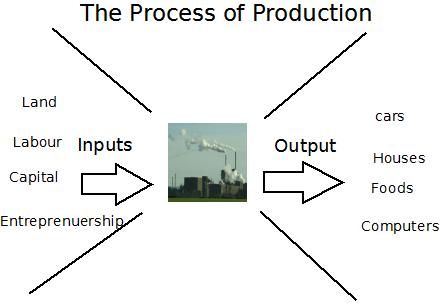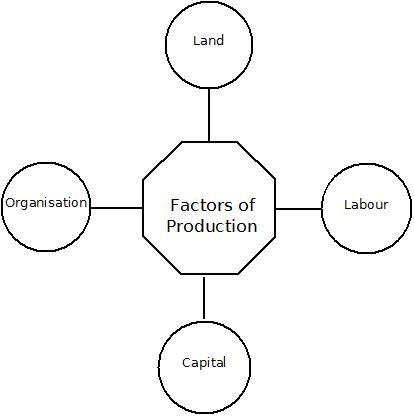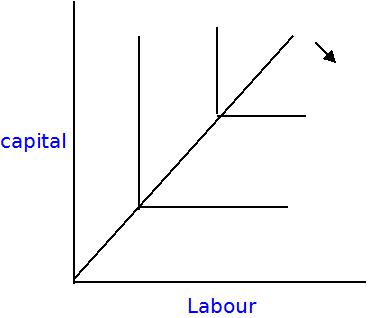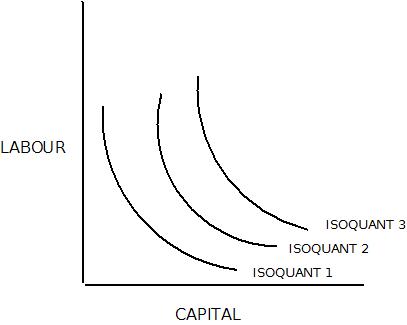PRODUCTION FUNCTION
MICROECONOMICS

|
Production Function |

|
Introduction |
Units on demand, elasticity of demand or consumer behaviour dealt with demand side of the market. Firms are the ones which supply the goods and services to the market. In order to have an understanding of the market, it is essential to learn about the behaviour of the firms. There are strong similarities between the optimising decisions made by firms and those made by consumers. The theory of firm describes how firms can make cost-minimising decisions, if they want to increase production, whether they should hire more labour or construct new plants or go for both.
| Types of Firm |
There are different types of firms that operate in the market. A road-side milk supplier is different from the other milk supplying firms Mother Dairy, Nestle, Gokul, etc. There are different types of firms. A quick review of the types of ownership of firms would be useful at this stage.
1.Individual Proprietorship– It refers to any business that is owned by a single owner or a single business family. A small provisional stores or a laundry shop is an individual proprietorship. Here the proprietor is responsible for anything good or bad happens to the business. Such firms may be registered or unregistered ones.
2. Partnership – Here there are groups of people who own the business. All of them are co-owners. There may be unlimited liability or each partner is totally liable for all what happens to the firm. That means if some payments are to be made and the other partners can not make, then one of them is fully liable to make the payments.
3. Corporations– In this form of a firm ownership, anyone can become a share-holder of a firm and have limited liability equal to his ownership share in the company. That means if Mr. X holds 20% of the company’s share, he is responsible for 20% of outstanding payments of that company. MTNL, Reliance Industries, Tata Motors, etc are the examples of corporations.
| Basic concepts related to the Theory of Firm |
Objectives of Firm
Like the rational consumers aim at maximising their satisfaction or utility, the firms aim at maximising their profits. Apart from profit maximisation, firms may aim at sales maximisation, revenue maximisation, good will among the consumers. Depending upon the type of ownership of a firm, the nature of objectives may change. For example, it is argued that, under corporation as a form of firm’s ownership, the objective of profit maximisation is replaced by the objective of sales maximisation. This is because, in big corporations, ownership of firm is separated from its management.
With this background information about the firm, its ownership structure and its objectives, let us begin with the analysis of the concept of production. A story of production and firm’s behaviour will be easier to follow once we take a note of following concepts:-
1.Prodution process
It is process by which the inputs or factors of production are transformed into output. In a cement factory, inputs include labour of its workers, raw materials such as limestone, sand, clay, and capital invested in equipment required to produce cement. Output of cement industry would be different varieties of cement.
2.Inputs or factors of production
There are four factors of production, land, labour, capital and organisation. All these are brought together in the process of production to form a final output. Land represents natural resources like land plots, minerals, water, oil, etc. Labour is considered to be an integral part of the process of production. Both skilled and unskilled labour is required by the firm. Capital represents physical capital in the form of machinery, equipment, plants, factory and other physical assets. Finally, organisation/entrepreneur brings all these factors of production together to transform them into a finished product.
3.Short run and the long run period
In the theory of production, short run is a period during which some of the factors of production mentioned above are constant. For example, in the short run, firm can not buy a new machine. So capital may remain constant in the short run. If it has to increase production in the short run, it may do so by hiring more contract labour to work on the same stock of machines or equipment. Long run, on the other hand, is a period, during which all the factors of production can vary. A firm can not only hire more/less labour but also can increase/reduce size of plant, buy more/sale existing stock of capital, and so on. One should keep in mind, the short-run and long-run period in production theory, is not time specific. For a poultry firm, for example, long run will be a period, till it increases its capacity by adding poultry stock (which may take say 2 weeks). But for a cement factory, it may take 2 years to increase its capacity by constructing a new plant. So long run for cement factory may be 2 years.
| Concept of Production Function |
As seen earlier, production involves a transformation of inputs into output. The technical relationship between inputs and output which gives maximum output is called production function. Production function gives different combinations inputs that produce maximum level of output. A production function is written as Q = f (I1....In) where, Q is output, f is a functional relationship and I1 to In are quantities of different inputs. To keep the things as simple as possible, at this stage, we will define production function as follows
Q = f (L, K)
Where
Q is output
L is labour used in process of production
K is capital used in the process of production
That means, firm’s output depends upon the labour employed and units of capital services used up in the production. Now, suppose a firm requires to increase its output, it cannot change the quantities of labour and capital at the same speed. Generally labour units can be employed at a short notice but it takes more time to install machinery or equipment i.e. capital. In the short run, one of the inputs may remain fixed say capital. Other inputs that may remain fixed in the short run may be supply of skilled labour, land plot, etc. But some inputs like unskilled labour units can be easily changed even in the short run.
So we can further define production function using the short-run and long-run period.
Short run production function ⇒ Q = f (L,K) where L is fixed factor and K is variable factor of production.
Long run production function ⇒ Q = f (L,K) where both L and K are variable factors of production.
| Types of Production Function |
There are two distinct types of production function that show possible range of substitution inputs in the production process.
1. Fixed proportion Production function
2. Variable proportions production function
These two types are based on the technical coefficient of production. The technical co-efficient is the amount of input required to produce a unit of output. For example, if 50 workers are required to produce 200 units of output, then 0.25 is the technical co-efficient of labour for production.
When 0.25 units of labour are required to produce every unit of output, it is called fixed proportion production function. Here, doubling of quantities of capital and labour in a required ratio will double the output. Fixed proportion production function can be illustrated with the help of isoquants. In this type of production function, the two factors of production, say labour and capital, should be used in a fixed proportion. The isoquants of such function are right angled as shown in the following diagram.
On the other hand, when the technical co-efficient to produce different units of output is varying or changing, it is called as the variable proportions production function. In such a type of production function, given amount of output can be produced with several alternative compbinations of labour and capital. Many commodities in real world are produced with variable proportion production function. For example, certain amount of wheat may be produced using more labour and less capital in India and more capital and less labour in USA. Variable proportion production function is illustrated in the following diagram.
The short run analysis of production function is done with one input variable (L) and the other input constant (K). The variation in the output resulting from different amounts labour applied to a fixed amount of capital is explained with the help of Law of Diminishing Returns or Law of Variable Proportions
The long run analysis of production function is done with both the inputs(L,K) variable. The variation in the output resulting from different amounts of labour and capital employed is explained with the help of Law of Returns to Scale
| Crops can be produced using different methods. Food grown on large farms in countries like Canada and the United States is usually produced with a capital intensive technology which involves substantial investment in capital, such as buildings and equipment, and relatively less input of labour. However, food can also be produced using very little capital (say a plough) and a lot of labour (several people) as is done in several parts of the developing countries. One way to describe the agricultural production process is to show one isoquant that describes the combination of inputs which generates a given level of output. The description that follows comes from a production function for wheat that is estimated using figures.
Following diagram shows one isoquant associated with the production function, corresponding to an some level output of per year. The farmer can use this isoquant to decide whether it is profitable to hire more labour or to use more machinery. The decision about how many labourers to hire and how much machinery to employ, will depend upon the cost of each input.[1]
|

|
Cobb-Douglas Production Function |
Many studies have been undertaken to empirically study and statistically calculate the relationship between physical inputs and physical output. One of such empirical production functions is Cobb Douglas Production Function. It is intermediate between a linear and a fixed proportion production function. It is given by a formula ------
Q = ALαKβ
Where Q is total output,
L stands for quantity of labour,
K is quantity of capital,
A, α and β are positive constants.
Empirically it was found that, 75% increase in output can be attributed to increase in labour input and the remaining 25% was due to capital input. It was also found that the sum of exponents of Cobb-Douglas production function is equal to one. That is α + β is equal to one. This implies that it is a linearly homogenous production function.
Following are important features of Cobb-Douglas Production Function
1. Average Product of factors of production used up in this function depends upon the ratio in which the factors are combined for the production of commodity under consideration
2. Marginal Product of factors of production used up in this function also depends upon the ratio in which the factors are combined for the production of commodity under consideration
3. Cobb-Douglas production function is used in obtaining marginal rate of technical substitution ( the rate at which one input can be substituted for the other to produce same level of output) between two inputs.
4. As seen earlier, the sum of exponents of Cobb Douglas production function is equal to one. (α + β = 1). This is a measure of returns to scale. When α + β = 1, it is constant returns to scale, α + β > 1, it indicates, increasing returns to scale and when α + β < 1, it indicates diminishing returns to scale.

|
Self-Assessment Questions (SAQs) {{{n}}} |
| {{{SAQ}}} | |
Can You solve this quiz?

|
Results |
In this part we have elaborately discussed the concept of production function, We have also examined different types of production function and with the help of isoquant technique, we have differentiated between these types of production function. We have also seen the important features of one of the empirical production function, Cobb-Douglas Production Function.

|
Key Terms |
Factors of Production - There are four factors of production that are used up in the process of production. These include - land, labour, capital and organisation
Process of Production -It is a process by which the factors of production are transformed into the final output.
Production Function -It is a technical relationship between inputs and given level of output.
Technical coeffcient of production- the amount of inputs required to produce a unit of output.
Fixed Proportion Production Function -It is a production function where technical coefficient of production is contant.
Variable Proportion Production Function -It is a production fucntion where technical co-efficient of production is variable.

|
Further Readings |
<reference>Pindyck, Rubinfeld and Mehta - Microeconomics, 7th edition</reference>
Cite error: <ref> tags exist, but no <references/> tag was found








